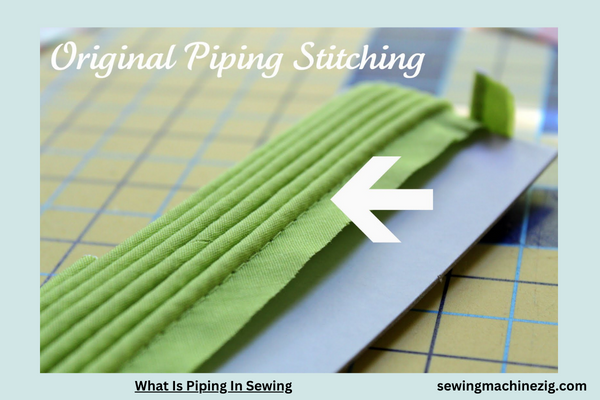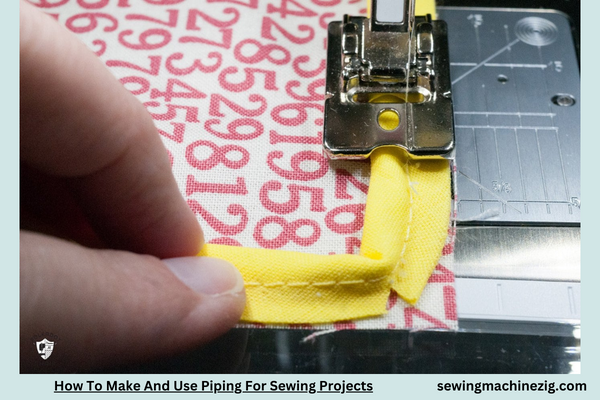
In the intricate world of sewing, mastering various techniques adds flair to your creations, and understanding “piping” is a stitch in that rich tapestry. What is piping in sewing, you might ask? Piping is more than a mere seam; it’s a design element that elevates your projects.
This guide delves into the nuances of piping, unraveling its purpose and methods. Whether you’re a sewing novice or a seasoned enthusiast, incorporating piping techniques can transform your creations, lending a touch of sophistication and detail. Let’s explore the art of piping and enhance your sewing repertoire.
What Is Piping In Sewing Detailed Answer

Piping in sewing is a technique that involves adding a thin, corded fabric trim to seams, hems, or edges to enhance and embellish the finished look of a garment or project.
Understanding what piping is and how to incorporate it into your sewing projects can elevate your creations. Follow this comprehensive step-by-step guide to master the art of piping in sewing.
Step 1: Gather Materials
Collect your sewing machine, fabric for piping, contrasting fabric for the main project, piping cord, scissors, pins, and a zipper foot for your sewing machine.
Step 2: Cut Strips for Piping
Determine the width of your piping and cut bias strips from your chosen fabric. The bias cut allows the fabric to curve smoothly around corners.
Step 3: Insert Piping Cord
Place the piping cord in the center of the bias strip, folding the fabric over it. Use a zipper foot on your sewing machine to stitch close to the cord, securing it in place.
Step 4: Prepare Main Fabric
Place the main fabric for your project right side up. Pin the piping along the seam line, ensuring the raw edges are aligned.
Step 5: Stitch Piping to Main Fabric
With the zipper foot still attached, stitch the piping to the main fabric, following the seam line. Stitch as close to the piping cord as possible for a neat finish.
Step 6: Join Piped Sections
When you reach a corner, snip into the seam allowance of the piping to allow it to bend smoothly. Join the piping ends neatly, trimming any excess fabric.
Step 7: Complete the Seam
Pin the other piece of the main fabric, right sides together, and stitch along the seam line, encapsulating the piping between the fabric layers.
Step 8: Clip and Grade Seams
Clip into the seam allowance around curves and trim the seam allowance near the piping to reduce bulk. This ensures a smooth, professional finish.
Step 9: Press the Seam
Press the seam carefully, setting the stitches and molding the piping for a polished look.
Step 10: Finishing Touches
Consider topstitching around the piped seam to secure the layers and add a decorative touch. This also helps the piping lay flat.
Step 11: Explore Variations
Experiment with different fabrics and cord sizes to create variations in your piping. This allows you to customize the look based on your project’s aesthetic.
Now that you understand what piping is in sewing and have mastered the step-by-step process, you can confidently incorporate this technique into your projects.
Piping adds a touch of sophistication and detail, elevating your creations to a new level of craftsmanship. Get creative and explore the versatility of piping in enhancing the visual appeal of your sewing endeavors.
How To Make And Use Piping For Sewing Projects

Let’s unravel the mystery behind piping in sewing and discover how to incorporate this delightful technique into your projects. So, What is piping in sewing, and how can you make and use it to add a touch of flair to your creations?
Understanding Piping in Sewing:
Piping is more than just a seam; it’s a decorative element that elevates your sewing projects. It involves adding a thin, corded fabric trim along seams, hems, or edges, creating a visually appealing contrast and adding a layer of sophistication to your designs.
Making Your Own Piping:
Creating piping for your sewing projects is a straightforward process. Start by cutting bias strips from your chosen fabric. Bias strips are cut at a 45-degree angle to the fabric’s grain, allowing for flexibility around curves and corners. Place a cord or filler inside the bias strip, folding the fabric over it. Secure the fabric around the cord by stitching close to the edge, creating your custom piping.
Using Piping in Sewing Projects:
Now that you’ve made your piping, let’s explore how to use it effectively:
Selecting Fabrics:
- Choose fabrics that complement each other for the main project and the piping. The contrast between the two fabrics will highlight the piping detail.
Aligning Fabric Edges:
- Place the fabric pieces right sides together, aligning the edges where you want to add the piping. Pin the piping along the seam line, making sure the raw edges are even.
Stitching Piping in Place:
- Using a zipper foot on your sewing machine, stitch the piping to the fabric, following the seam line. Stitch as close to the cord as possible for a neat finish.
Joining Piped Sections:
- When you reach a corner, snip into the seam allowance of the piping to allow it to bend smoothly. Join the piping ends neatly, trimming any excess fabric.
Completing the Seam:
- Pin the other fabric piece’s right sides together and stitch along the seam line, encapsulating the piping between the fabric layers.
Clipping and Pressing:
- Clip into the seam allowance around curves and trim the seam allowance near the piping to reduce bulk. Press the seam carefully to set the stitches and mold the piping.
Topstitching for a Polished Look:
- Consider topstitching around the piped seam to secure the layers and add a decorative touch. This step also helps the piping lay flat and enhances the overall finish.
Exploring Piping Variations:
Get creative with your piping by experimenting with different fabrics and cord sizes. This allows you to customize the look based on your project’s aesthetic, whether you’re aiming for subtle elegance or bold statement details.
Piping in sewing is a versatile technique that adds a layer of sophistication to your creations. By understanding the process of making and using piping, you can elevate your sewing projects and infuse them with a touch of personalized style. So, go ahead, grab your fabrics and cords, and let the piping adventure begin!
Conclusion
In conclusion, “What is piping in sewing” understanding what piping in sewing entails unveils a delightful technique to elevate your projects. Piping, a decorative seam finish, involves adding a corded fabric trim for visual contrast and sophistication. Learning how to make and use piping opens up creative avenues, allowing you to customize your designs.
Whether subtly enhancing edges or creating intricate details, piping adds a personalized touch to sewing projects, transforming them into beautifully finished creations with a touch of flair.
FAQS
Q1: What exactly is piping in sewing?
A1: Piping in sewing refers to a decorative technique where a thin, corded fabric strip is added along seams, hems, or edges to create visual contrast and add sophistication to a project.
Q2: What materials do I need to make piping for my sewing projects?
A2: To make piping, you’ll need your chosen fabric, a cord or filler, a sewing machine, and basic sewing tools like scissors and pins.
Q3: Can I use any fabric for making piping?
A3: Yes, you can use a variety of fabrics for making piping, depending on your project. Cotton and silk are popular choices for a softer look, while sturdier fabrics like denim work well for a more structured appearance.
Q4: How do I incorporate piping into my sewing projects?
A4: To use piping in sewing, pin it along the desired seam or edge before stitching. Sew the layers together, encasing the piping, and enjoy the polished, decorative finish. “What is piping in sewing“
Q5: Is piping suitable for both clothing and home decor projects?
A5: Absolutely! Piping is versatile and can enhance both clothing items, like collars and cuffs, and home decor projects, such as pillows, cushions, and upholstery. “What is piping in sewing“
Q6: Can I buy pre-made piping for my sewing projects?
A6: Yes, pre-made piping is readily available in various colors and sizes. It’s a convenient option if you prefer to skip the process of making your own. “What is piping in sewing“



